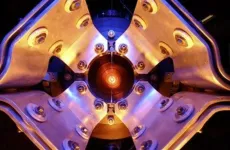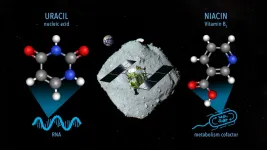(Press-News.org) If you’ve ever been admitted to hospital or visited an emergency department, you’ve likely had an electrocardiogram, or ECG, a standard test involving tiny electrodes taped to your chest that checks your heart’s rhythm and electrical activity.
Hospital ECGs are usually read by a doctor or nurse at your bedside, but now researchers are using artificial intelligence to glean even more information from those results to improve your care and the health-care system all at once.
In recently published findings, the research team built and trained machine learning programs based on 1.6 million ECGs done on 244,077 patients in northern Alberta between 2007 and 2020. The algorithm predicted the risk of death from that point for each patient from all causes within one month, one year and five years with an 85 per cent accuracy rate, sorting patients into five categories from lowest to highest risk. The predictions were even more accurate when demographic information (age and sex) and six standard laboratory blood test results were included.
The study is a proof-of-concept for using routinely collected data to improve individual care and allow the health-care system to “learn” as it goes, according to principal investigator Padma Kaul, professor of medicine and co-director of the Canadian VIGOUR Centre.
“We wanted to know whether we could use new methods like artificial intelligence and machine learning to analyze the data and identify patients who are at higher risk for mortality,” Kaul explains. “These findings illustrate how machine learning models can be employed to convert data collected routinely in clinical practice to knowledge that can be used to augment decision-making at the point of care as part of a learning health-care system.”
A clinician will order an electrocardiogram if you have high blood pressure or symptoms of heart disease, such as chest pain, shortness of breath or an irregular heartbeat. The first phase of the study examined ECG results in all patients, but Kaul and her team hope to refine these models for particular subgroups of patients. They also plan to focus the predictions beyond all-cause mortality to look specifically at heart-related causes of death.
“We want to take data generated by the health-care system, convert it into knowledge and feed it back into the system so that we can improve care and outcomes. That’s the definition of a learning health-care system.”
END
Machine learning programs predict risk of death based on results from routine hospital tests
Computer analysis can help the health-care system “learn” by providing information vital to improving care, says researcher
2023-03-21
ELSE PRESS RELEASES FROM THIS DATE:
Imaging the proton with neutrinos
2023-03-21
The Science
Protons and neutrons, the building blocks of atomic nuclei, are themselves made up of strongly interacting quarks and gluons">quarks and gluons. Because the interactions are so strong, the structure of protons and neutrons is difficult to calculate from theory. Instead, scientists must measure it experimentally. Neutrino experiments use targets that are nuclei made of many protons and neutrons bound together. This complicates interpreting those measurements to infer proton structure. ...
To ward off aging, stem cells must take out the trash
2023-03-21
In humanity’s ongoing quest for the elixir of life, the science keeps pointing to stem cells. Research increasingly shows that maintaining stem cell fitness promotes a long healthspan, and new findings show keeping stem cells clean and tidy is an integral step.
In a study published March 21, 2023 in Cell Stem Cell, researchers at University of California San Diego School of Medicine found that blood stem cells use an unexpected method to get rid of their misfolded proteins, and that this pathway’s ...
Uracil found in Ryugu samples
2023-03-21
Samples from the asteroid Ryugu collected by the Hayabusa2 mission contain nitrogenous organic compounds, including the nucleobase uracil, which is a part of RNA.
Researchers have analyzed samples of asteroid Ryugu collected by the Japanese Space Agency’s Hayabusa2 spacecraft and found uracil—one of the informational units that make up RNA, the molecules that contain the instructions for how to build and operate living organisms. Nicotinic acid, also known as Vitamin B3 or niacin, which is an important cofactor for metabolism in living organisms, was also detected in the same samples.
This discovery by an international team, led by Associate Professor ...
Honey, the 3D print--I mean, dessert--is ready!
2023-03-21
New York, NY—March 21, 2023—Cooking devices that incorporate three-dimensional (3D) printers, lasers, or other software-driven processes may soon replace conventional cooking appliances such as ovens, stovetops, and microwaves. But will people want to use a 3D printer--even one as beautifully designed as a high-end coffee maker--on their kitchen counters to calibrate the exact micro- and macro-nutrients they need to stay healthy? Will 3D food printing improve the ways we nourish ourselves? What sorts of ...
Albert Einstein College of Medicine and Montefiore Health System awarded $30 million from NIH to support its Institute for Clinical and Translational Research
2023-03-21
March 21, 2023—BRONX, NY—Albert Einstein College of Medicine and Montefiore Health System have received a seven-year, $30 million grant from the National Institutes of Health (NIH) to continue support for the Harold and Muriel Block Institute for Clinical and Translational Research at Einstein and Montefiore (ICTR). The latest Clinical and Translational Science Award (CTSA) will ensure the ICTR will further its vision to improve health in the Bronx, Westchester, and lower Hudson Valley by accelerating the translation of scientific discoveries into effective and equitable prevention and treatment approaches.
“Since establishing ...
Diet and exercise programs alone won’t tackle childhood obesity
2023-03-21
Focusing on immediate fixes such as diet and exercise programs alone won’t curb the tide of childhood obesity, according to a new study that for the first time maps the complex pathways that lead to obesity in childhood.
Coordinated by the University of Sydney’s Charles Perkins Centre the study finds children whose parents did not complete high school and who live with social disadvantage, were more likely to be affected by overweight or obesity in mid-adolescence. High school completion is a strong indicator of socio-economic status.
These factors were ‘on ramps’ which flow down to influence the body ...
New Yale study evaluates PAXLOVID’s use in Long COVID recovery
2023-03-21
New Haven, Conn. — Yale School of Medicine announces the initiation of a novel, randomized trial that will test whether receiving PAXLOVIDTM (nirmatrelvir tablets; ritonavir tablets) for 15 days can improve the health of highly symptomatic adults with Long COVID.
The trial, led by Yale School of Medicine Professors Harlan Krumholz and Akiko Iwasaki, has a decentralized design, meaning that participants do not have to travel to study sites. It also uses a novel, participant-centric, digital approach to data collection.
Long COVID, also known as post-acute sequelae SARS-CoV-2 ...
ESMT Berlin: New book on how industrial companies can survive deglobalization
2023-03-21
Deglobalization and the unpredictability of global business have led technology-based industries to review their overall strategies. Current geopolitical changes – the war in Ukraine, effects of the pandemic, and greenhouse gas emission targets – revived discussions about the value of globalization. However, international trade of goods and services has been slowing down significantly since 2011, with increasing nationalism being a factor. Additionally, lower salary differentials between developed and emerging economies have reduced overseas product shipments – which are increasingly criticized regarding environmental impact. So, how ...
Scientists find a common thread linking subatomic color glass condensate and massive black holes
2023-03-21
The Science
Physicists have discovered a remarkable correspondence between dense states of gluons—the gluelike carriers of the strong nuclear force within atomic nuclei—and enormous black holes in the cosmos. The dense walls of gluons, known as a color glass condensate (CGC), are generated in collisions of atomic nuclei. This CGC measures a mere 10-19 kilometers across—less than a billionth of a kilometer. Black holes, in contrast, span billions of kilometers across. The new work shows that both systems are made of densely packed, self-interacting force carrier particles. In CGC, those particles are ...
Vocal tract size, shape dictate speech sounds
2023-03-21
WASHINGTON, March 21, 2023 – Only humans have the ability to use speech. Remarkably, this communication is understandable across accent, social background, and anatomy despite a wide variety of ways to produce the necessary sounds.
In JASA, published on behalf of the Acoustical Society of America by AIP Publishing, researchers from University Hospital and Medical Faculty of the RWTH Aachen University explored how anatomical variations in a speaker’s vocal tract affect speech production.
The vocal tract looks like an air duct, starting at the vocal cords and moving vertically through the larynx before bending at the back of the mouth and running ...
LAST 30 PRESS RELEASES:
James Webb telescope reveals spectacular atmospheric escape
ICE-CSIC leads a pioneering study on the feasibility of asteroid mining
Dramatic rise in young people using mental health services
Be careful trusting TikTok for gout advice
A study by the University of Seville links the vanishing of the specific heats at absolute zero with the principle of entropy increase
Anxiety and insomnia may lower natural killer cell count, potentially repressing immune function
How parasitic, asexual plants evolve and live
Research spotlight: A subset of patients with depression could benefit from anti-inflammatory treatment
New fully digital design paves the way for scalable probabilistic computing
Membrane electrode assembly design for high-efficiency anion exchange membrane water electrolysis
U.S. debt ceiling disputes show measurable impact on global crude oil markets
Climate extremes triggered rare coral disease and mass mortality on the Great Barrier Reef
Direct observation reveals “two-in-one” roles of plasma turbulence
Humans rank between meerkats and beavers in monogamy ‘league table’
US fossil reveals early mass-burial event and ancient microbial attack
Sedative choice could improve outcomes for breathing tube patients
New superconducting thin film for quantum computer chips
Simulations reveal protein "dynamin" constricts cell membranes by loosening its grip
Nearly 1 in 5 UK emergency department patients cared for in corridors/waiting rooms
Heavy energy drink intake may pose serious stroke risk, doctors warn
Violence against women and children among top health threats: New global study reveals disease burden far larger than previously estimated
Predicting who is at risk of developing type 1 diabetes, as new drugs now available
New gene-mapping method unlocks hidden drivers of cancer
Ocean current and seabed shape influence warm water circulation under ice shelves
Call to increase funding for ‘invisible’ Deaf victim-survivors of domestic abuse
University of Maryland School of Medicine names distinguished scientist and academic leader Gerald M. Wilson, PhD, as Chair of the Department of Biochemistry and Molecular Biology
Receptors in mammary glands make livestock and humans inviting hosts for avian flu
Icy hot plasmas
Treating adults with autism: Maryland Clinical Center offers national blueprint for care after pediatric transition
University of Phoenix College of Doctoral Studies releases white paper on reclaiming control to build workforce resilience
[Press-News.org] Machine learning programs predict risk of death based on results from routine hospital testsComputer analysis can help the health-care system “learn” by providing information vital to improving care, says researcher






